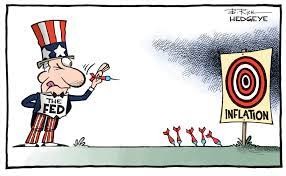
Hello friends, welcome to the May 2022 market outlook. On May 4th, the Federal Reserve hiked interest rate by 50 basis points. The move was widely expected but historic. It was the largest rate hike for the U.S. economy since May 2000. Prior to the move, markets have been under severe stress. The decline was not just in stocks, bonds added significantly to the carnage. The traditional 60/40 portfolio, beloved by most investors over the past decades, has never performed worse. Going back and looking at the numbers, these were the worst years for a 60/40: 1977 (4.2), 1981 (1.6), 1990 (3.9), 1994 (3.0), 2001 (1.8), 2002 (2.2) 2005 (2.0), 2020 (3.4). Now, 2022 stands at a decline of 11.5% in early May. Bonds once provided investors protection, that’s currently not the case.
Following the rate hike decision markets rallied aggressively. The reason for the rally, Chair Powell shot down the need for a 75 basis point hike in the future. We don’t share that belief. Were markets preemptive to price in tighter financial conditions in 2022 and 2023? Maybe, but that would depend on whether or not you believe the Fed is behind the eight ball, or, that inflation will be persistent for much longer than markets or investors had priced in. We err on the latter side. Future rate decisions will depend on levels of inflation, growth and the unemployment rate. And it doesn’t change the fact that rates are now 50 bps higher, are going to be another 50 bps higher next month and likely another 50 bps higher the month after that.
Following the rate decision, the yield on the 10 year dropped back under 3%. As of this writing, the yield on the 10 year is now at 3.10%! Watch the 10 year yield- the higher the yield, the more stocks will be under pressure, especially tech, which has been the biggest decliner of the market this year. With the yield at 3.10%, the S&P is back to where it was yesterday, giving up the entire 3% rally that followed the rate hike decision. Yesterday was easy. Going forward, we expect volatility in the markets.
There’s an argument being made that Fed can make a policy error by hiking too aggressively. We disagree, Chairman Powell and the Federal Reserve already have made a major policy error in waiting too long to tighten, and the economy is paying the price for their mistake. Fed policy cannot quickly remedy the persistent supply chain disruptions or the energy and labor shortage or antitrust policies – three major forces behind inflation. The only way to bring down inflation is to tighten financial conditions. Speaking of supply chain, the average time for US manufacturers to receive production materials rose to 100 days in April, it’s the longest span ever. Some 15% of manufacturers worried about Asian partners reliably making deliveries in the summer months, up from 5% in March. It seems as if supply channels are set to worsen before they improve.
It’s our hope the Ukrainian crisis ends soon. We previously mentioned this, but May 9th, known as Victory day in Russia, is a major holiday. It wouldn’t be surprising if Putin pulls back from his assault and annexes regions like Mariupol and calls it a victory. Of course, a cease fire would likely be celebrated by the markets, lower inflation expectations and potentially lower chance of food crises erupting in 2023.
The chances for U.S recession in 2023 still hover around 30%, but we won’t really know until the tightening process plays out. Depending on growth rates and how healthy the consumer and households are at the time will be a major factor. Demand destruction will occur when the US consumer starts to have second thoughts on higher prices, and we know it will hit lower income people first. Yesterday TransUnion released a study on ‘consumer resiliency amid rising inflation.’ Not surprisingly, “non-prime borrowers – those consumers with the riskiest credit profiles – have generally experienced the greatest impact to their wallets.” This new study “found that non-prime borrowers have seen the greatest percentage rise in both credit balances and delinquency rates since early 2021, which coincides with the period when inflation has risen significantly.”
The consumer outside of this cohort remains strong, for now, “the study found that even though credit balances are rising, more consumers are making payments each month over their minimum due amounts, an indication of consumer resiliency.” Which means that the current tightness in the labor market is keeping this all together. If there are any changes to that labor strength in coming quarters we’ll have a whole new level of economic challenges. Let’s hope the consumer stays strong and is able to weather this tightening process.
From a portfolio perspective, we’ve been continuing to put cash to work in value stocks and small and mid-cap names. If you’re a long term investor, prices are getting attractive. We continue to believe value will outperform growth, real estate will stay strong, commodities will be in favor for longer than investors expect and you want to avoid bonds with long duration. That’s it for this month. Please stay safe and don’t hesitate to reach out with any questions.
PLEASE SEE IMPORTANT DISCLOSURE INFORMATION: Read More
